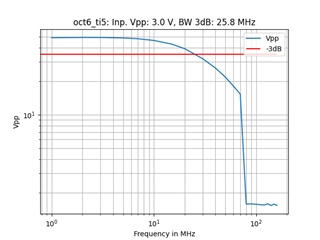Tool/software:
We have evaluated the THS3470 on the evaluation board THS3470EVM.
Setup:
OPV was powered with +-30, current limited to 2A. Output voltage was 50Vpp. Output was connect with 1m RG58 cable to Lecroy Oscilloscope with high impedance (1MOhm).
Amplification 5 as delivered. All switches in middle position, as delivered.
Input frequency was programmatically increased from 1 MHz to 150 MHz. Oscilloscope measured Vpp.
Fan was running.
In the middle of the measurement (frequency was increased programmatically) the OPV dies. Supply voltage drops to 1.5V at 2A for both +30V and -30V.
Here are the recorded measurement results:

I would expect that the IC was driven under normal operation conditions and I wonder why it was killed.
Are there any comments?
Regards, Guenter

